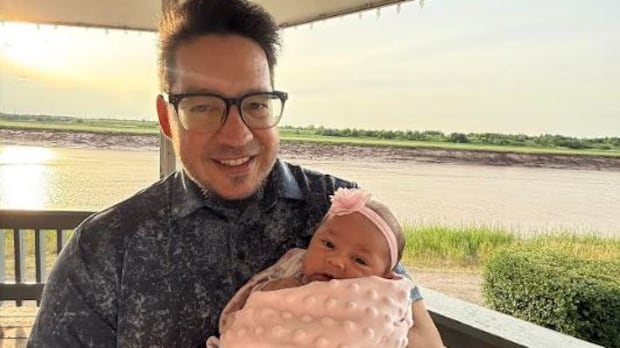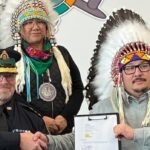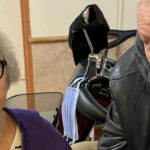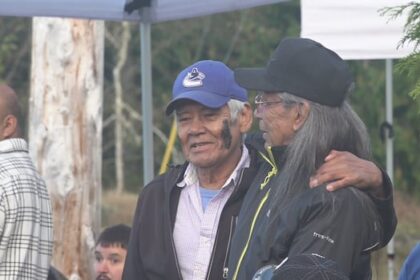IndigenousA Mi’kmaw man from Elsipogtog First Nation in New Brunswick says his granddaughter will be the first in his family to not be eligible for status because of the Indian Act’s second-generation cut-off rule. Elsipogtog man worries his family will be ‘erased’ under Indian Act rulesSis’moqon · CBC News · Posted: Oct 22, 2025 2:58 PM EDT | Last Updated: 1 hour agoDJ Joseph holds his new granddaughter, Oaklynn, who is the first in his lineage not to be eligible for Indian status. (Submitted by DJ Joseph)A Mi’kmaw man from Elsipogtog First Nation in New Brunswick says his granddaughter will be the first in his lineage to be ineligible for Indian status. “To me it’s the fear of being erased from history,” said DJ Joseph. Joseph was born, raised and worked most of his life in Elsipogtog, a Mi’kmaw community 90 kilometres north of Moncton. However, due to the second-generation cut-off rule that removes status after two generations of one non-status parent, his new granddaughter is not eligible for status under the Indian Act.Advocates say amendments to the Indian Act currently under review in the Senate fail to address the issue, leaving more families to face similar circumstances as the Josephs in the coming years. “My granddaughter, and other grandchildren to come… Are they even ever gonna be able to say that they’re Mi’kmaw?” said Joseph.“According to the government, they can’t.”Joseph’s daughters Jada, Jennica, and Madison, with his granddaughter Oaklynn. Joseph said of this photo, ‘They all represent the finality of my bloodline, if this part of the Indian Act continues.’ (Submitted by DJ Joseph)Prior to 1985, Indian status was passed down almost exclusively through men. That year, it changed to a system of counting status grandparents and the 6(2) category was created. A person with two status parents is registered under section 6(1), and a person with only one status parent is registered under 6(2). Both have access to the same services, but the difference lies in the ability to pass on status to their children.Joseph has 6(1) status. His daughter’s mother is not First Nations, so his daughter has 6(2) status. His daughter’s child with a non-First Nations person — his granddaughter born in May — is not eligible for status. “It seems so intentionally done by the government,” said Joseph. “I’m not one to talk like that, but it’s hard not to when you really start thinking about it. What I hope for the future is that this is eliminated, or at least the status can be passed down through other means or Elsipogtog can take control of our own registry.”Elsipogtog is a under section 11 band membership, meaning the control of its membership list is in the hands of Indigenous Services Canada (ISC). So when a person eligible for status through Elsipogtog parents is registered, they are automatically added to the band’s membership list. This is in contrast to section 10 band membership, under which a community can develop its own membership codes and people can be added as members in accordance with those membership codes. However the federal government retains registration for Indian status.Bill S-2, currently in consideration in the Senate, is the latest in a series of bills aiming to correct sex discrimination around registration in the Indian Act. It doesn’t carry any provisions about the second-generation cut-off, nor around recognizing sovereignty of First Nations people to control band membership. Communities should determine membership, says national chiefAssembly of First Nations National Chief Cindy Woodhouse Nepinak said it’s time to transfer control over who is eligible for status to communities, and rid the Indian Act of the second-generation cut-off rule. “The government needs to get out of the way and allow First Nations the space, and the resources to develop their own membership codes,” said Woodhouse Nepinak. “We know our own people from our communities and we need to be given full control over our membership.”Assembly of First Nations National Chief Cindy Woodhouse Nepinak says the cost of eliminating the second-generation cut-off shouldn’t be a factor. (Jean-Francois Benoit/CBC)Although she supports most of what Bill S-2 addresses, she said Bill S-2 lacks action in three major areas: First Nations self-determination over citizenship, removal of the second-generation cut-off, and a funding mechanism to handle the addition of people who will be newly eligible for status. “I think that there’s always concerns around the government not giving enough funding to First Nations to do the services that are needed,” said Woodhouse Nepinak.She said the government should not use its apprehension on providing additional funding for those newly eligible for status if the second-generation cut-off is removed as a reason not to remove it.ISC consulting on second-generation cut-offIn an email to CBC Indigenous, a representative from ISC said as of January 2025, 29 per cent of the registered First Nations population is registered as 6(2). “If the legislation doesn’t change, the number of registered First Nations people is expected to grow from about 1.1 million to 1.6 million by 2066, but over the next three to four generations, the number of people eligible for status will start to decline,” said the email.ISC is working to advance Bill S-2, while undertaking separate consultations on the second-generation cut-off, the email said.“First Nations partners have been clear that addressing the subsection 6(2) cut-off is a critical matter that requires urgent attention,” said the email.“That is why both are happening in parallel.”ISC launched a consultation process on the second-generation cut-off at the end of 2023. Ninety First Nations and organizations have expressed interest in submitting proposals to solve the issue and those reports are due in December. ABOUT THE AUTHORSis’moqon is a Mi’kmaw woman from Ugpi’ganjig First Nation. She is a reporter with CBC Indigenous. She currently resides in Kjipuktuk, also known as Halifax. You can email her at sis.moqon@cbc.ca with story ideas.
Wednesday, 17 Dec 2025
Canada – The Illusion
Search
Have an existing account?
Sign In
© 2022 Foxiz News Network. Ruby Design Company. All Rights Reserved.
You May also Like
- More News:
- history
- Standing Bear Network
- John Gonzalez
- ᐊᔭᐦᑊ ayahp — It happened
- Creation
- Beneath the Water
- Olympic gold medal
- Jim Thorpe
- type O blood
- the bringer of life
- Raven
- Wás’agi
- NoiseCat
- 'Sugarcane'
- The rivers still sing
- ᑲᓂᐸᐏᐟ ᒪᐢᑿ
- ᐅᑳᐤ okâw — We remember
- ᐊᓂᓈᐯᐃᐧᐣ aninâpêwin — Truth
- This is what it means to be human.
- Nokoma










